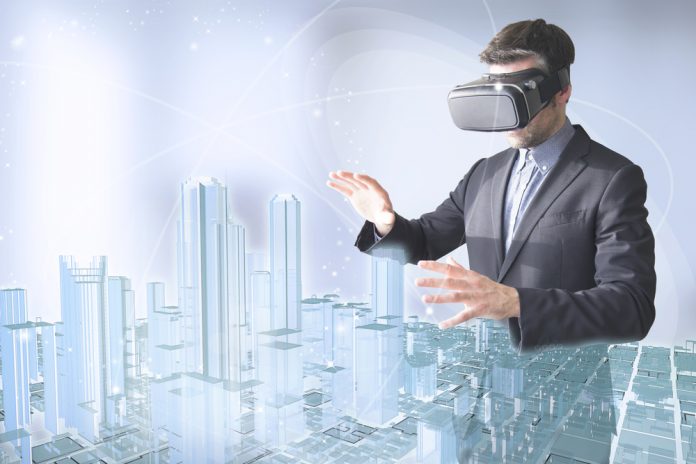Originally conceived as a more immersive experience for gamers, Virtual Reality (VR) has stepped out of the gaming industry and into other sectors. Why has VR suddenly exploded into the mainstream? Where is it heading and what does it mean for your business? We’ll explain. But first, if you aren’t familiar with VR, here’s what you need to know.
What is VR?
We’ve been trying to recreate reality in many different ways over the past one hundred years. From flight simulators to more immersive cinema experiences, VR has a long history dating back to the late 1920s.
The aim is to take users from their own reality into a virtual, digitally created version. Properly created, VR can make users feel as though the world they’re experiencing is real, evoking the same, if not stronger, emotional, mental and physical responses as real life.
Currently accessed by donning a gigantic headset, people can experience new surroundings, different cultures and meet new people through software-generated technology.
The science isn’t quite there yet to make VR a properly wearable solution that’s accessible and affordable to businesses and individuals. But that’s likely to come as more industries seek to exploit the benefits this technology can bring.
VR Growth Curve
Driven by the gaming industry, VR has been used to help gamers feel like they are in the game, not simply playing it. Thanks to the development of depth-sensing cameras, sensor suites, motion controllers and natural human interfaces, the crucial elements for successful VR are already part of everyday computing.
With the explosion of small, powerful mobile technology, VR has started to become more wearable and more advanced. Yet, until recently, the technology still wasn’t great, and the experience was a poor replica of the real world.
The technology took a major leap forwards when VR enthusiast Palmer Luckey dropped out of university to develop a high-quality VR gaming headset. Despite sounding like something out of the latest Transformers movie, Oculus Rift is often touted as the most realistic VR headset available.
With integrated headphones for a 3D audio effect, the system uses a stationary infrared sensor to pick up light emitted by the head-mounted display. This allows the system to create a 3D space allowing the user to sit, stand or walk around the same room using rotational and position tracking to orientate the player in the game.
The purchase of Oculus Rift by Facebook for $2bn in 2014 signifies a vote of confidence in the direction of VR technology and the potential for it to connect human to human.
When Can You Expect to Be Using VR?
As with any new technology there are early adopters: in this case, gamers. But for VR to become a mainstream reality, sufficient people need to buy the hard and software to use any apps that are developed for it to work.
It’s predicted it will take around eight to ten years to see VR hardware sales reach a tipping point. By 2025, it’s likely there will be 135m VR headsets in use of which 122m will be mobile.
Thanks to Facebook’s acquisition of Oculus Rift, social networking is the most likely way for VR to become mainstream. That said, there are other predictions for VR’s use in the business world. Here are three.
Five Ways VR Could Change Your Business (But Not For a While)
- VR Meetings
Hate wasting time and money on journeys to hold face-to-face meetings? Not a fan of online video conferences where only one person can talk at a time?
VR meetings are set to change all that. Simply don your headset, plug in and join the meeting. You’ll be represented by your chosen avatar and transported to a virtual meeting space where you can walk around and choose who to sit next to, just like a real meeting. It’s anticipated that you’ll also be able to identify more nuanced non-verbal communication taking video conferencing up another notch.
- Enhanced Collaboration
Working hard on a project only to have your results rejected by a manager, colleagues or even the customer is heartbreaking. If only you could collaborate more effectively, earlier in the process. With VR, you’ll be able to do just that.
By creating a virtual environment, you can assess the effectiveness of a digitally-created version of your solution in real-time. Ford are already ahead of the curve having used VR to design their cars for years.
Using Oculus Rift in their Immersion Lab, their engineers can analyse the car through 360° and can even sit inside it to give them a realistic sense of the driver’s experience. All without touching a scrap of metal or starting to build.
- Immersive Learning
Classroom-based training might be safer and less costly than getting people to undertake the actual work, but it doesn’t always make for the best experience. However, with VR, businesses will be able to simulate dangerous or risky situations within a controlled environment where learning can safely take place.
It’s hoped that this technology will be used to create accurate and realistic simulations that could be applied to a range of situations including customer services, engineering and design. Using a highly visual approach aids the understanding of complex concepts and theories and supports learning which could mean shorter training times and reduced costs.
Although it’s probably not time to go out and buy an Oculus Rift just yet, the development of VR tech is one to watch.
This article was written by Barry Lowe, Founder and Managing Director of San-iT a specialist in Cloud Computing Solutions.







